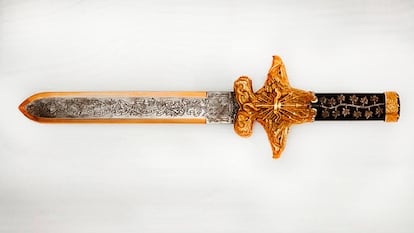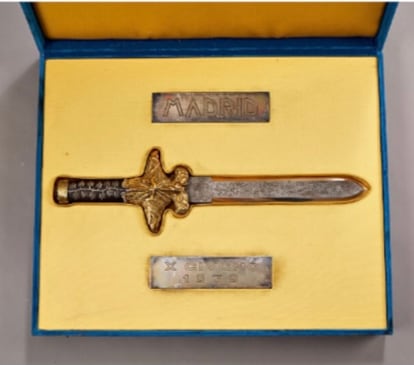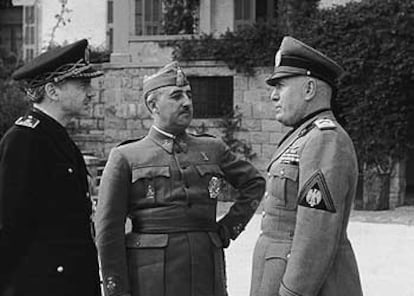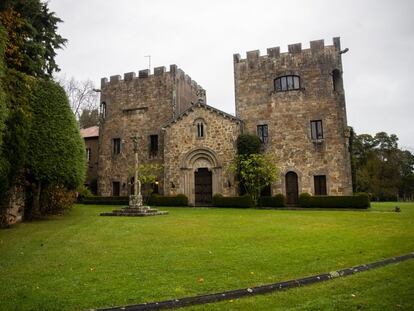Dagger allegedly belonging to Franco sold at auction for €35,000
According to the auctioneers, the item was given to the Spanish dictator by Mussolini’s son-in-law to congratulate him on his victory in the Civil War


The German auction house Andreas Thies held an auction on April 10 of 587 military objects ranging from soldiers’ helmets, flags and uniforms to medals and antique weapons. The cheapest, a semi-automatic pistol, sold for €50. The most expensive, which fetched €35,000, is described in the catalog as “a museum piece of goldsmithing difficult to surpass and a unique historical relic from the history of Spanish and Italian fascism. A magnificent gift of a dagger from the Italian minister of foreign affairs, Count Ciano, to General Francisco Franco.”
The auction house claims that Count Ciano, the son-in-law of fascist leader Benito Mussolini, gave the dagger to Franco to congratulate him “on the occasion of the victory of the Spanish fascists and the allied regimes of Germany and Italy in the Spanish Civil War.” The support of Italians and Germans was decisive in the victory for the Spanish dictator and far more significant in terms of resources and men, than the collaboration of the International Brigades with the Republican side, says historian, Ángel Viñas.
There was never any investigation into which gifts he had received as head of state and which were given in a private capacity. Everything became part of the family inheritanceHistorian Francisco Prado-Villar
Sources from the Franco family’s entourage claim to have no knowledge of the dagger’s sale. Government sources point out that in order to carry out these kinds of auctions, the auction house is bound to confirm the authenticity of the object and ensure it is not protected. Historian Gregorio Arencibia, who uses these types of auction houses to acquire historical documents for the Arucas Association of Historical Memory of Arucas in the Canary Islands, says objects of this kind often come up for sale when in his opinion “they should be in a museum as part of the national heritage.”
Fashioned in gold with 19 diamonds, the dagger is engraved with the coats of arms representing Italian fascism as well as the yoke and arrows of Spain’s fascist Falange party. The grip bears the initials F. F. and the message “to Generalissimo Franco” is inscribed on one side. The presentation box, lined with blue velvet, includes a copper relief depicting St. George slaying the dragon and a shield with the inscription “Together we conquer. Madrid, June 10, 1939.”
Viñas explains that in July, 1939, Ciano, who had taken the last Italian troops in Spain from Cádiz back to Naples, came back to Spain to return a visit that the brother-in-law of Carmen Polo – Franco’s wife, Ramón Serrano Suñer, had paid him weeks earlier. Suñer deeply admired Mussolini, whom he described in an interview as “one of the few geniuses that history creates every two or three thousand years.” The Spanish dictator, however, was not quite so positive about his Italian counterpart, as Viñas points out. “Franco was fed up with Mussolini taking credit for his victories,” he says. “They were both interested in controlling Morocco and they clashed over the war debt because Franco did not want to pay as much.” Ciano ended up becoming Mussolini’s most implacable critic within the Fascist Council and his father-in-law sentenced him to death in 1944. Years later, Ciano’s son Fabrizio would write the book, When Granddad Executed Dad.
“No control”
According to historian Francisco Prado-Villar, whose research has been key in the struggle to get the Franco family to return the 800-year-old Portico of Glory statues of Abraham and Isaac originally from the Santiago de Compostela Cathedral, “there was no control over the many gifts that were made to the dictator and the people who had the control were totally coerced by the regime. There was never any investigation into which gifts he had received as head of state and which were given in a private capacity. Everything became part of the family inheritance.”
A spokesperson for Spain’s National Heritage Trust confirms that there was no legislation dictating what should be done with the gifts that Franco received from institutions or other heads of state.

A gift for Franco that did reach Spain – unlike the dagger – was a spectacular German Mercedes of which only three were made – one being kept by Nazi leader Adolf Hitler and the other two given to Franco and Mussolini. But there were other assets in Franco’s possession that seem to come to him and his family on a help-yourself basis. The historian Prado-Vilar, a researcher at the Real Colegio Compuletense at Harvard University, flags up two examples of Franco’s plundering – the Pazo de Meirás estate in Galicia and the Portico of Glory sculptures. “If they did that with real estate, what would they not have thought to do with the furniture within!” he says.
The A Coruña Provincial Court in Galicia, confirmed last February that a country estate known as Pazo de Meirás belongs to the state, after it was established that the sale and purchase of the property in 1941 was a mere “simulation” and therefore null and void. An order was also issued to prevent the dictator’s grandchildren from picking through its contents until they were examined – a procedure that showed a number of them clearly had their origin in the Spanish Royal Collections.
The inventory of the contents of Pazo de Meirás consists of 697 objects, but Prado-Vilar believes that, aside from the statues, the Franco family must have taken items of greater value than those listed. In his book, Un Pueblo Traicionado (or A People Betrayed), British historian and Franco biographer Paul Preston cites the total figure of 4,000 million pesetas – around €24 million – in gifts to the dictator “probably not including the value of the hundreds of commemorative gold medals given to him by towns and entities across Spain and which Doña Carmen [his wife] melted down for ingots.”

There are the alleged donations, such as the Pazo de Meirás summer palace and gifts sent out of fear or admiration or to satisfy the whims of Carmen Polo. “In her apartment, there was a room where the walls were lined, from floor to ceiling, with forty columns of twenty drawers containing a jumble of jewels,” writes Preston who also mentions an alliance between several jewelry stores to share out the losses every time Franco’s wife went to see them. Sometimes she would covet a piece of jewelry and other times, medieval pylons – as was the case when she visited the church of San Xiao of Moraime, in Muxía, A Coruña. Lawyer Celso Alcaina fought to reclaim these possessions for years.
When Franco died, Carmen Polo watched as the countless jewels, antiques, paintings and tapestries were loaded onto trucks to be moved to various family properties or to safe havens abroad. It is alleged that there were valuable objects among them that belonged to the state, but that no representative from the National Heritage Trust was present to vouch for this, according to Preston. The ruling from the A Coruña Provincial Court confirming state ownership of the Pazo de Meirás property mentions that during the democratic transition following Franco’s death in 1975, concessions were made to Franco’s circle with “generous renunciations for the sake of coexistence and democratic normalization.”
The new Historical Memory Law being drawn up by the central government includes a commitment to carry out an audit of “plundered assets” during Franco’s regime, with no compensation to the family for reclaimed assets. In 1935, Franco received a salary as head of state of 2,429.98 pesetas – the equivalent today of about €5,300. By 1940, he had the equivalent of €388 million in his bank account.
English version by Heather Galloway.
Tu suscripción se está usando en otro dispositivo
¿Quieres añadir otro usuario a tu suscripción?
Si continúas leyendo en este dispositivo, no se podrá leer en el otro.
FlechaTu suscripción se está usando en otro dispositivo y solo puedes acceder a EL PAÍS desde un dispositivo a la vez.
Si quieres compartir tu cuenta, cambia tu suscripción a la modalidad Premium, así podrás añadir otro usuario. Cada uno accederá con su propia cuenta de email, lo que os permitirá personalizar vuestra experiencia en EL PAÍS.
¿Tienes una suscripción de empresa? Accede aquí para contratar más cuentas.
En el caso de no saber quién está usando tu cuenta, te recomendamos cambiar tu contraseña aquí.
Si decides continuar compartiendo tu cuenta, este mensaje se mostrará en tu dispositivo y en el de la otra persona que está usando tu cuenta de forma indefinida, afectando a tu experiencia de lectura. Puedes consultar aquí los términos y condiciones de la suscripción digital.
More information
Últimas noticias
Most viewed
- Reinhard Genzel, Nobel laureate in physics: ‘One-minute videos will never give you the truth’
- Oona Chaplin: ‘I told James Cameron that I was living in a treehouse and starting a permaculture project with a friend’
- Pablo Escobar’s hippos: A serious environmental problem, 40 years on
- Why we lost the habit of sleeping in two segments and how that changed our sense of time
- Chevy Chase, the beloved comedian who was a monster off camera: ‘Not everyone hated him, just the people who’ve worked with him’










































